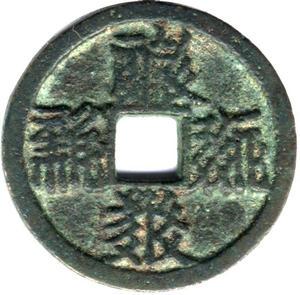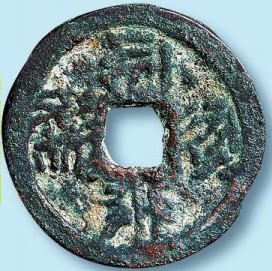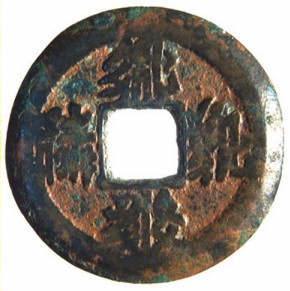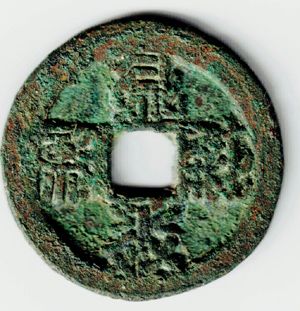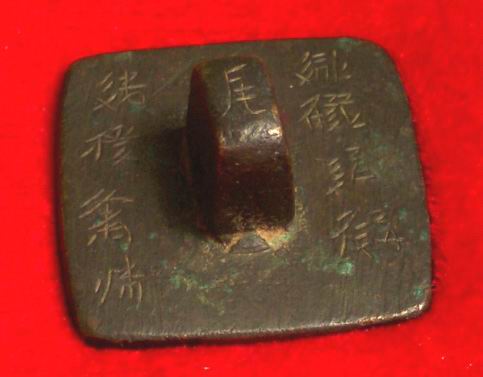BabelStone Blog
Monday, 29 January 2007
Tangut Coins
In my previous post I discussed a Yuan dynasty coin with a Tangut character on it, so I thought that as a follow-up to this it would be a useful learning exercise for me to have a go at reading the Tangut inscriptions on the coins that were issued by the Western Xia 西夏 regime during the 11th-12th centuries. Now I'm sure that someone has already analysed all the Tangut coin inscriptions in some obscure journal somewhere, but I don't have easy access to a research library, so I have had to try to read all the inscriptions from the coins myself using my somewhat limited Tangut reference materials (Wenhai Yanjiu and the index to Li Fanwen's Tangut Dictionary).
But as Amritas said in his most recent Tangut blog post, Nothing is ever easy when it comes to Tangut. Coins with Tangut inscriptions vary from very uncommon to extremely rare, and most surviving examples are badly worn, making it very difficult to make a confident reading, especially given the nature of Tangut characters (almost always very complex but often differentiated from other characters by only subtle differences, and on top of this the glyphs encountered in actual inscriptions often differ significantly from the dictionary form of the character). The situation is made even worse by the fact that there are considerably more fake Tangut coins in circulation than there are genuine coins, some of which have completely spurious inscriptions but others which are hard to tell from the real thing. Thus, after three weeks of investigation, although I have managed to interpret the inscriptions on most of the coins, there are still several points of doubt which await future resolution.
The Western Xia regime (1032-1227) issued two types of Chinese-style cash coins, one with an inscription in Chinese characters, and one with an inscription in Tangut characters on the obverse (and normally a plain reverse). The Tangut inscription on these coins always comprises four characters, reading clockwise (top-right-bottom-left), meaning "Precious Coin of the ... Reign Period". At present coins with Tangut inscriptions are known from six different reign periods, but there may be more waiting to be discovered (the Zhengde Baoqian type is known only from a single example discovered in 1999).
| Coin | Chinese Translation |
Tangut Inscription | Reading* | Reign Period |
Example Coin |
|---|---|---|---|---|---|
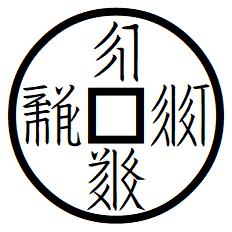 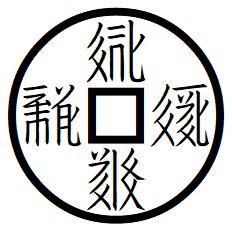 |
Fusheng Baoqian 福聖寶錢 |
𗼃𗼕𘏨𘔭 | śjɨj ljo ljɨ̣ dzjɨj | Fusheng Chengdao 福聖承道 [1053-1056] NB These are two different readings of the same coin |
Zeno #16068 |
| Bingde Baoqian 稟德寶錢 |
𗣼𗧯𘏨𘔭 | tśhja ꞏji̲j ljɨ̣ dzjɨj | |||
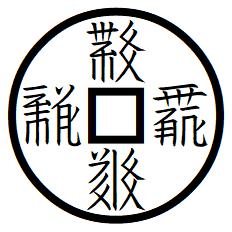 |
Da'an Baoqian 大安寶錢 |
𘜶𗵐𘏨𘔭 | tha nej ljɨ̣ dzjɨj | Da'an 大安 [1076-1085] |
Zeno #1084 |
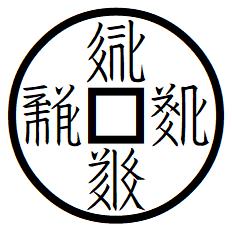 |
Zhenguan Baoqian 貞觀寶錢 Guande Baoqian 觀德寶錢 |
𗣼𘝯𘏨𘔭 | tśhja bio̲ ljɨ̣ dzjɨj | Zhenguan 貞觀 [1102-1114] |
Zeno #78 |
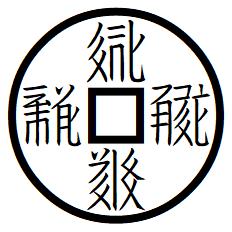 |
Zhengde Baoqian 正德寶錢 Zhide Baoqian 治德寶錢 |
𗣼𘇚𘏨𘔭 | tśhja mji̲ ljɨ̣ dzjɨj | Zhengde 正德 [1127-1134] |
|
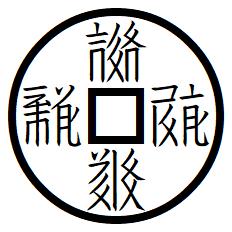 |
Qianyou Baoqian 乾祐寶錢 |
𘀗𘑨𘏨𘔭 | tshjwu ꞏwu ljɨ̣ dzjɨj | Qianyou 乾祐 [1171-1193] |
Zeno #16071 |
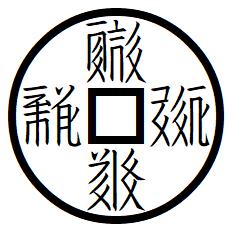 |
Tianqing Baoqian 天慶寶錢 |
𘓺𘅝𘏨𘔭 | ŋwər ljwu ljɨ̣ dzjɨj | Tianqing 天慶 [1194-1205] |
Zeno #1332 |
*The readings are the phonetic reconstructions given in Li Fanwen 李範文, Xia-Han Zidian 夏漢字典 [A Tangut-Chinese Dictionary] (Beijing: Zhongguo Shehui Kexue Chubanshe, 1997).
Character References
| Tangut | Reading | Chinese | References |
|---|---|---|---|
| 𗵐 | nej | ān 安 | XHZD #0139, WHYJ #2920 |
| 𘅝 | ljwu | qìng 慶 | XHZD #0305, WHYJ #3264 |
| 𗘞 | lha | shèng 聖 | XHZD #0480, WHYJ #1089 |
| 𘓺 | ŋwər | tiān 天 | XHZD #0510, WHYJ #4454 |
| 𘑨 | ꞏwu | yòu 祐 | XHZD #0645, WHYJ #4150 |
| 𘇚 | mji̲ | zhì 治 | XHZD #0720, WHYJ #3194 |
| 𘔭 | dzjɨj | qián 錢 | XHZD #1604, WHYJ #4429 |
| 𗧯 | ꞏji̲j | bǐng 稟 = 秉 | XHZD #2135, WHYJ #2448 |
| 𗼕 | ljo | fú 福 | XHZD #2342, WHYJ #3650 |
| 𗼃 | śjɨj | shèng 聖 | XHZD #2544, WHYJ #3628 |
| 𗣼 | tśhja | dé 德 | XHZD #2748, WHYJ #2239 |
| 𘀗 | tshjwu | qián 乾 | XHZD #3950, WHYJ #2781 |
| 𘜶 | tha | dà 大 | XHZD #4457, WHYJ #4815 |
| 𘝯 | bio̲ | guān 觀 | XHZD #5593, WHYJ #4773 |
| 𘏨 | ljɨ̣ | bǎo 寶 | XHZD #5655, WHYJ #3824 |
XHZD = Xia-Han Zidian 夏漢字典 (1997).
WHYJ = Wenhai Yanjiu 文海研究 (1983).
The readings for the Da'an Baoqian 大安寶錢, Qianyou Baoqian 乾祐寶錢 and Tianqing Baoqian 天慶寶錢 coins are clear and unambiguous. In each case the top and right Tangut characters of the coin correspond in meaning directly to the Chinese characters for the relevant reign period, and are written in the same word order as the corresponding Chinese characters :
| 𘜶 (dà 大) + 𗵐 (ān 安) = 𘜶𗵐 Da'an 大安 [1076-1085] |
| 𘀗 (qián 乾) + 𘑨 (yòu 祐) = 𘀗𘑨 Qianyou 乾祐 [1171-1193] |
| 𘓺 (tiān 天) + 𘅝 (qìng 慶) = 𘓺𘅝 Tianqing 天慶 [1194-1205] |
However, the inscriptions on the other three coin types are quite problematic, and are discussed in more detail below.
Fusheng Baoqian 福聖寶錢 or Bingde Baoqian 稟德寶錢 ?
This coin is supposed to have been minted during the Fusheng Chengdao 福聖承道 [1053-1056] period, and as such it is reputed to be the earliest known example of the Tangut script (officially promulgated in 1036). It is also the coin that I have had most dificulty with. This coin is not as rare as some of the other Tangut script coins (seven Fusheng Baoqian coins were unearthed from a hoard at Wushenqi 烏審旗 in Inner Mongolia), but none of the examples available on the internet or in my coin books have a clear enough inscription to make a certain reading. The top character is particularly obscure on all the genuine coins that I have seen. Due to the poor condition of most examples of this coin, it has been difficult to get a definitive reading of the Tangut inscription, and so there are two different theories as to what characters are inscribed on it.
The inscription on this coin was first translated by Luo Fuchang 羅福萇 in 1914 (see Addendum for details), who read the top character as 𗼃 (XHZD #2544, WHYJ #3628) corresponding to Chinese shèng 聖, and the righthand character as 𗼕 (XHZD #2342, WHYJ #3650) corresponding to Chinese fú 福. Taking into account Tangut word order this gives a reading of fú shèng 福聖, being an abbreviation of the name of the Fusheng Chengdao 福聖承道 reign period. Interestingly Luo Fuchang reverses the order of these two characters in his Tangut transcription of the coin (reading the coin in the order right, top, bottom, left), so that they correspond to Chinese word order, Fusheng 福聖 :

However, Luo Fuchang's reading of Fusheng 福聖 is not universally accepted. There is an article by Nie Hongyin 聶鴻音 that discusses the problematic identification of the "Fusheng" reign period, but unfortunately it is only accessible by subscription. From what I can glean from Google (which seems to have access to the full text of subscription journals such as these) the author believes that according to Tangut custom the name of the Fusheng Chengdao 福聖承道 reign period should be abbreviated as Chengdao 承道 not Fusheng 福聖, and that the Tangut characters corresponding to Chinese bǐng dé suì 稟德歲 found in the colophon to the Tangut translation of the Thousand Names of the Buddhas of the Past Sutra 過去莊嚴劫千佛名經 are equivalent to "Chengdao period" 承道年. This theory accords with the view of Chen Bingying 陳炳應 that the inscription on the Fusheng Baoqian coin should be read as Bingde Baoqian 稟德寶錢.
The resolution of the image of the colophon to the Tangut translation of the Thousand Names of the Buddhas of the Past Sutra (also in Shijie Zongjiao Yanjiu 世界宗教研究 1981.1 p.75) is not good enough for me to be a hundred percent certain what the Tangut characters are that correspond to the Chinese translation bǐng dé 稟德 (line 18 characters 6-7 of the colophon), but I am pretty sure they must be 𗧯 XHZD #2135 (WHYJ #2448) and 𗣼 XHZD #2748 (WHYJ #2239) respectively, as they are the only characters that correspond in meaning to Chinese bǐng 稟 (= 秉) "to hold" and dé 德 "virtue". Looking at the coin, with a little imagination you can see that the top character does indeed resemble the Tangut character corresponding to Chinese dé 德 "virtue" (XHZD #2748), but with a long vertical line as the righthand element. And on at least one coin the righthand character does look as if it might just be the character corresponding to Chinese bǐng 稟 (= 秉) "to hold" (XHZD #2135). This reversed word order (dé bǐng 德稟) is expected according to Tangut grammar, although on the Da'an, Qianyou and Tianqing coins the Tangut characters follow Chinese word order. However, there does not seem to be a satisfactory explanation as to why bǐng dé 稟(秉)德 "uphold virtue" should be equivalent to the Chinese chéng dào 承道 "follow the way", i.e. why do the Tangut characters corresponding to Chinese bǐng dé 稟(秉)德 refer to the [Fusheng] Chengdao [福聖]承道 reign period ?
There are thus two completely different readings of the Tangut inscription on this coin, neither entirely convincing. Looking at the image of an actual coin next to the two suggested readings (as shown above), it is difficult to make a decision on the righthand character, but to me the top character does look closer to 𗧯 (dé 德) than 𗼃 (shèng 聖). But until a much clearer example of this coin comes to light, it is not possible to be sure whether the inscription is Fusheng Baoqian 福聖寶錢 (𗼃𗼕𘏨𘔭), Bingde Baoqian 稟德寶錢 (𗣼𗧯𘏨𘔭), or something else entirely.
Zhenguan Baoqian 貞觀寶錢 ?
The inscription on this type of coin was translated by Zhao Quanzhi 趙權之 in 1937 as zhēn guān bǎo qián 貞觀寶錢 "precious coin of the Zhenguan period", but looking at the coin it would appear that this is not a literal translation of the Tangut characters. The two reign period characters are quite clear on several of the coins of this type, and so we can confidently identify the top character as corresponding to the Chinese character dé 德 "virtue" (XHZD #2748) and the righthand character as corresponding to the Chinese character guān 觀 "to observe" (XHZD #5593). So we have dé 德 "virtue" rather than the expected zhēn 貞 "chaste, faithful", and as the character zhēn 貞 is actually equivalent to the character zhèng 正 "upright, correct" in the compound zhēn guān 貞觀, I don't think you can claim that dé 德 is nearly synonymous with zhēn 貞. Furthermore, given Tangut word order, these two characters would probably correspond to Chinese guān dé 觀德 "observing virtue", which takes us even further away from zhēn guān 貞觀. So all in all I'm not convinced that the inscription on this coin does necessarily correspond to the Zhenguan period [1102-1114].
Zhengde Baoqian 正德寶錢 ?
Only one example of this coin is known, and that was discovered in 1999. It was valued on a Chinese TV programme about antiques and collectables as being worth at least RMB 200,000 (about USD 25,000). The programme's Tangut expert, Bai Bin 白濱 (one of the compilers of WHYJ), provided the following explanation of the inscription :
It's first character is dé 德 [virtue], and the second character ought to be zhì 治 [govern]. zhì dé is in fact the same as zhèng dé; so it is a "precious coin of the Zhengde period".
它的第一個字“德”,第二個字應該是個“治”字,“治德”實際上就是“正德”,是正德寶錢。
Well, I have to agree that the top character is indeed dé 德 (XHZD #2748) and the second character, although not terribly clear, does look like as if it could be the Tangut character corresponding to Chinese zhì 治 (XHZD #0720). In fact we are helped in the identification of these two characters by a Tangut seal (coinicidentally also revealed to the world on a Chinese TV programme) which appears to have the same two characters as a date on its reverse :
As is invariably the case, the column of characters on the left of the knob is the name of the seal's owner, and the column of the characters on the right of the knob is the date that the seal was bestowed on its owner. In this case the first two characters on the righthand column 𗣼𘇚 appear to be the same as the first two characters on the coin. According to the above-quoted expert we reverse the two Tangut characters to get the corresponding Chinese compound zhì dé 治德 "governing virtue", and then for some unexplained reason we substitute zhèng 正 "correct, upright" for zhì 治 "govern" to magically get the reign period Zhengde 正德 ... at this point I call time out.
I'm beginning to get really suspicious of the Tangut character corresponding to Chinese dé 德 that coincidentally just happens to occur as the first character on the inscription of the "Fusheng" ("Bingde"), "Zhenguan" and "Zhengde" coins. For the Da'an 大安, Qianyou 乾祐 and Tianqing 天慶 coins the Tangut inscription corresponds exactly to the reign period in Chinese, with no change of word order (same also applies for the Tangut characters corresponding to the Tiansheng 天盛 period [1149-1170] which occur on a number of Tangut seals), but with the other three coins we have to jump through hoops to get to the name of the reign period in Chinese :
| 𗣼𗧯 dé bǐng 德稟 ⇒ bǐng dé 稟德 ⇒ chéng dào 承道 |
| 𗣼𘝯 dé guān 德觀 ⇒ guān dé 觀德 ⇒ zhēn guān 貞觀 |
| 𗣼𘇚 dé zhì 德治 ⇒ zhì dé 治德 ⇒ zhèng dé 正德 |
I just don't buy it. I think that there must be some other more reasonable interpretation of the meaning of these three Tangut coin inscriptions that doesn't involve the magical substitution of one character for another ... if only I had any idea what that explanation was.
And Finally ...
If you want to find out more about Western Xia culture and see some more examples of the Tangut script on various documents and artefacts, these are some interesting online exhibitions (in Chinese) :
- 大夏寻踪——西夏文物特展 (Exhibition on Western Xia artefacts at the National Museum of China)
- 西夏文献 (exhibition on Western Xia documents at the National Library of China)
- 文明之光-中国古代少数民族语言文献 (exhibition on documents relating to ancient nationalities at the National Library of China, including three examples of Tangut writing)
- 西夏文文献样品 (some examples of Tangut documents, including a beautiful chrysography edition of the Lotus Sutra -- see also On the Xixia Version of the Lotus Sutra by the great Japanese Tangut scholar Tatsuo Nishida)
Addendum [2007-03-17]
S.W. Bushell
I have recently had the opportunity to look at the earliest decipherment of Tangut coins, by S.W.Bushell in his "The Hsi Hsia Dynasty of Tangut, Their Money and Peculiar Script" (Journal of the North China Branch of the Royal Asiatic Society Vol.XXX (1895-1896) pp.142-160). In this ground-breaking article Bushell deciphers 37 Tangut characters from various inscriptions, as shown below :
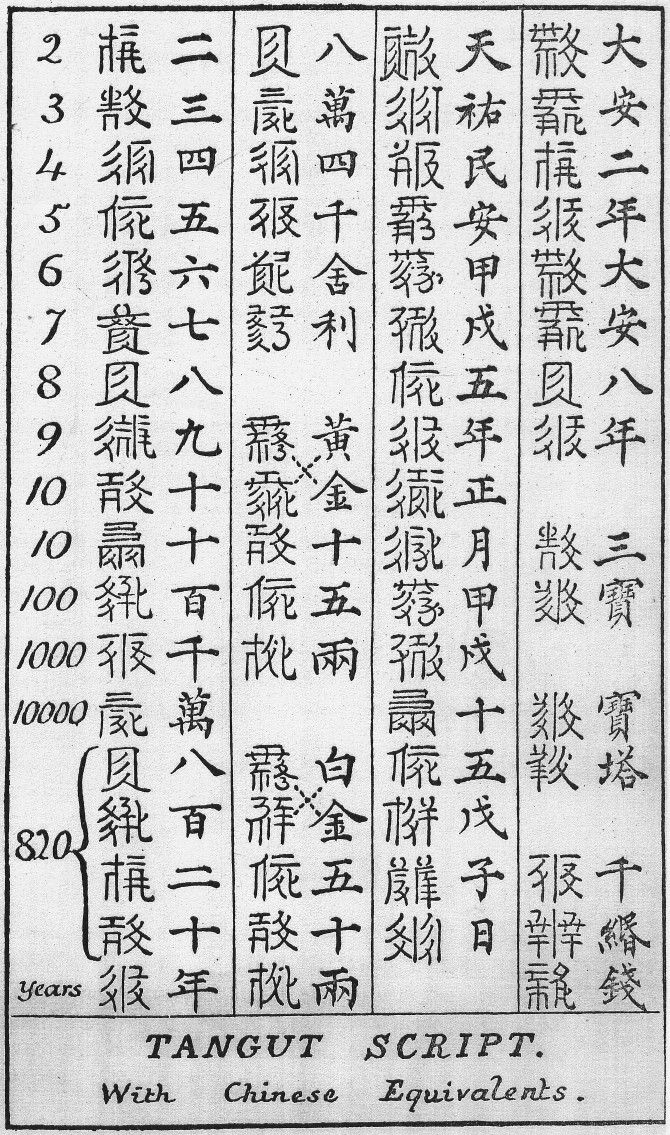
Based on this he was able to read the legend on the Da'an Baoqian 大安寶錢 coin, and was thus the first person in modern times to be able to understand the writing on a Tangut coin. He also illustrates a Qianyou Baoqian 乾祐寶錢 coin, but is unable to decipher the reign period on it.
Luo Zhenyu and his Sons
In China the first modern scholar to become interested in the Tangut script was Luo Zhenyu 羅振玉 (1866-1940), who in 1912 published a facsimile edition of nine pages from the Fanhan Heshi Zhangzhongzhu 番漢合時掌中珠 "Pearl in the Hand", and in 1927 published a compiliation of 33 Tangut seals Xixia Guanyin Jicun 西夏官印集存. Luo Zhenyu passed on his interest in the Tangut script to his first, third and fifth sons, who all published important books on the Tangut script :
- Luo Fucheng 羅福成, author of Xixia-yi Lianhuajing Kaoshi 西夏譯蓮華經考釋 "A Study of the Tangut translation of the Lotus Sutra" (1914) and Xixia Guoshu Leibian 西夏國書類編 (1915), and publisher of the first facsimile edition of Yin Tong 音同 "Homophones".
- Luo Fuchang 羅福萇 (1896-1921), author of a marvellous handbook on the Tangut script, Xixia Guoshu Lueshuo 西夏國書略說 (1914?) that I only looked at for the first time a few days ago.
- Luo Fuyi 羅福頤 (1905-1981), who (with Li Fanwen 李範文) edited a compilation of 97 Tangut seals, Xixia Guanyin Huikao 西夏官印匯考 (1982).
In Luo Fuchang's handbook of the Tangut script he gives readings for the Fusheng Baoqian 福聖寶錢, Da'an Baoqian 大安寶錢, Qianyou Baoqian 乾祐寶錢 and Tianqing Baoqian 天慶寶錢 coins.
Last modified: 2017-01-01 (updated with Unicode Tangut characters)
If Tangut characters do not display correctly, please download and install the Tangut Yinchuan font.
Index of BabelStone Blog Posts
